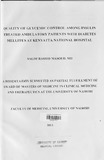Quality of glycemic control among insulin treated ambulatory patients with Diabetes Melitus at Kenyatta National Hospital
| dc.contributor.author | Masoud, Salim R | |
| dc.date.accessioned | 2013-02-12T14:47:43Z | |
| dc.date.available | 2013-02-12T14:47:43Z | |
| dc.date.issued | 2012 | |
| dc.identifier.uri | http://erepository.uonbi.ac.ke:8080/xmlui/handle/123456789/9348 | |
| dc.description.abstract | Background: Diabetes mellitus is one of the most prevalent NCDs associated with increasing morbidity. mortality and socio-economic burden. Lowering blood sugar levels as close to normal as possible is associated with improved morbidity and mortality in patients with diabetes. Insulin is an effective medication that can reduce any elevated level of Al C to recommended targets. All patients with TlDM and eventually majority with T2DM require insulin to achiese near normal glycemic levels. Despite improved therapy and knowledge. glucose control is still unsatisfactory in many patients. Data on the quality of control in Kenya. especially on insulin treated patients. is scarce and limited. Objective: Determine the quality of glycemic control and patient, disease and treatment factors associated with quality of glycemic control among insulin treated ambulatory diabetic patients at the diabetic outpatient clinic at KNH. Design: Cross-sectional descriptive study Setting: Diabetic Outpatient clinic at KNH. Subjects: Ambulatory patients with diabetes on insulin therapy for at least 3 months Main Outcome measure: Al C. Materials and Methods: A designated questionnaire and analysis of blood samples for AIC were used to collect data from consecutively sampled patients. The data was analyzed using SPSS version 17.0. Results: From 1.018 ambulatory patients attending the diabetic clinic at KNH. 212 patients on insulin therapy for at least 3 months were recruited. 66.5% were females. The mean (SO) age was 53.4( 17.4) years. Mean (SD) age at disease onset was 39.6 (16.1) years. Median duration of disease and duration of insulin use were 11.1 and 6.0 years. respectively. Sixty four percent were adherent to insulin injections and only 5.2% monitored sugars at least once per day. 201 samples were analyzed for Al C. The mean (SD) AIC was 9.4(2.2) % with a range of between 5.2 and 15.0%. Eighty six percent had Al C above or equal to 7% and were considered poorly controlled. Seventy percent had Al C above or equal to 8% whereas 42% had Al C equal or above 10%. Glycemic control was significantly associated with age at disease onset (P. 0.017) and duration of insulin use (P. 0.041). Conclusion: Overwhelming majority of ambulatory patients with diabetes mellitus on insulin attending the diabetic clinic at KNH were poorly controlled. Early age at disease onset and longer duration of insulin use were associated with poor control. | en_US |
| dc.language.iso | en_US | en_US |
| dc.publisher | University of Nairobi, Kenya | en_US |
| dc.title | Quality of glycemic control among insulin treated ambulatory patients with Diabetes Melitus at Kenyatta National Hospital | en_US |
| dc.title.alternative | Thesis (M.Med.) | en_US |
| dc.type | Thesis | en_US |

